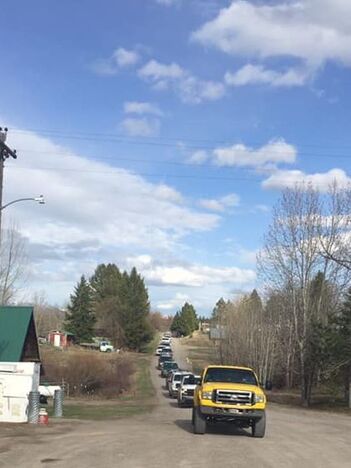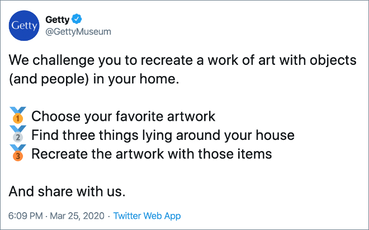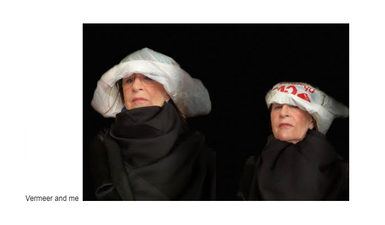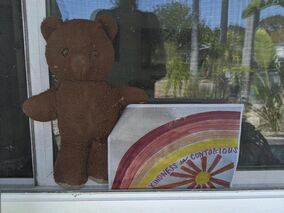
We're here!
April 27, 2020
The other day—it was a gray chilly Spring evening—the long quiet of quarantined Ovando was suddenly broken by the blare of horns honking triumphantly. I leapt to the window and there indeed was a parade of cars and pick-ups circling the small square below my window. The message was so clear: We’re here! Ovando is here, alive and well! It really made me smile. It was so, well, Ovando. A little while later I went out for a walk as dusk was falling and I saw Fred across the street ready to leave from the store. His wife Leigh Ann was in the car and I was delighted to see her and catch up a bit from 6 feet away! Yes, they had been in the “parade” and yes, the message was the one I had received: “Ovando is here, alive and well.”
The other day—it was a gray chilly Spring evening—the long quiet of quarantined Ovando was suddenly broken by the blare of horns honking triumphantly. I leapt to the window and there indeed was a parade of cars and pick-ups circling the small square below my window. The message was so clear: We’re here! Ovando is here, alive and well! It really made me smile. It was so, well, Ovando. A little while later I went out for a walk as dusk was falling and I saw Fred across the street ready to leave from the store. His wife Leigh Ann was in the car and I was delighted to see her and catch up a bit from 6 feet away! Yes, they had been in the “parade” and yes, the message was the one I had received: “Ovando is here, alive and well.”
 Here they come!!
Here they come!! It began with an invitation from
Angela Williams on Facebook,
“Everyone welcome.
Let’s all get out and show our community support in these trying times."
Load up in your favorite hot wheels
and join us!!
Meet at Trixis parking lot,
cruise the metropolis of Ovando,
then highway to Helmville
and cruise that metropolis!
“There were about 50 cars,” Leigh Ann said.
Angela has been one of the people in town busily
making face masks for any who want them.
Bravo! Angela, and all of the dragsters who lifted spirits in two metropolitan areas!
_______________________________________________
Angela Williams on Facebook,
“Everyone welcome.
Let’s all get out and show our community support in these trying times."
Load up in your favorite hot wheels
and join us!!
Meet at Trixis parking lot,
cruise the metropolis of Ovando,
then highway to Helmville
and cruise that metropolis!
“There were about 50 cars,” Leigh Ann said.
Angela has been one of the people in town busily
making face masks for any who want them.
Bravo! Angela, and all of the dragsters who lifted spirits in two metropolitan areas!
_______________________________________________
Christmas Eve, 1968. As one of the most turbulent, tragic years in American history drew to a close, millions around the world were watching and listening as the Apollo 8 astronauts - Frank Borman, Jim Lovell and Bill Anders - became the first humans to orbit another world. --NASA
The “turbulent and tragic year” saw the assassinations of Martin Luther King Jr. and Robert Kennedy, as well as some of the worst massacres of the Vietnam War, which would take the lives of an estimated 2,000,000 to 3,000,000 people; 58,000 American lives. Sadly, wars were not new on our planet but something else was. In Earth’s 4 billion year history, no one had ever seen the Earth. The Apollo 8 astronauts Frank Borman, Bill Anders and Jim Lovell were the first.
ANDERS: There was essentially zero interest in images of Earth from Space. Nobody told me to take a picture of the Earth. We all knew ABOUT the Earth. They wanted photographs of something that was unusual. Close-ups of the far-side of the Moon.
LOVELL: Space is black. Ink black. The Moon is all shades of gray.
BORMAN: The moon is a vast, lonely, forbidding type of existence or expanse of nothing. No matter how closely you looked, it was crater upon crater. After about an hour, I’m thinking it’s kind of boring.
We’d spent all these revolutions looking at the Moon, then as we come around this uninviting place we look up and there’s the Earth. It was small enough you could cover it with your thumb nail and everything we held dear—our families, our country, everything we held dear was back on that blue planet. …How in the world could this little ball exist in this vast universe of nothing?
ANDERS: We were all awestruck by the beauty of the Earth against the blackness of Space. “Wow! Isn’t that pretty? Hand me a roll of color quick. Oh man, that’s a beautiful shot,” I said.
BORMAN: I believe all 3 of us had an emotional reaction to seeing the Earth. The dearest things in life were back on the Earth. My family, my wife… And when we landed, there it was. My wife, my family, my co-workers clapping and cheering. The most emotional part of the flight for me was the homecoming.
The “turbulent and tragic year” saw the assassinations of Martin Luther King Jr. and Robert Kennedy, as well as some of the worst massacres of the Vietnam War, which would take the lives of an estimated 2,000,000 to 3,000,000 people; 58,000 American lives. Sadly, wars were not new on our planet but something else was. In Earth’s 4 billion year history, no one had ever seen the Earth. The Apollo 8 astronauts Frank Borman, Bill Anders and Jim Lovell were the first.
ANDERS: There was essentially zero interest in images of Earth from Space. Nobody told me to take a picture of the Earth. We all knew ABOUT the Earth. They wanted photographs of something that was unusual. Close-ups of the far-side of the Moon.
LOVELL: Space is black. Ink black. The Moon is all shades of gray.
BORMAN: The moon is a vast, lonely, forbidding type of existence or expanse of nothing. No matter how closely you looked, it was crater upon crater. After about an hour, I’m thinking it’s kind of boring.
We’d spent all these revolutions looking at the Moon, then as we come around this uninviting place we look up and there’s the Earth. It was small enough you could cover it with your thumb nail and everything we held dear—our families, our country, everything we held dear was back on that blue planet. …How in the world could this little ball exist in this vast universe of nothing?
ANDERS: We were all awestruck by the beauty of the Earth against the blackness of Space. “Wow! Isn’t that pretty? Hand me a roll of color quick. Oh man, that’s a beautiful shot,” I said.
BORMAN: I believe all 3 of us had an emotional reaction to seeing the Earth. The dearest things in life were back on the Earth. My family, my wife… And when we landed, there it was. My wife, my family, my co-workers clapping and cheering. The most emotional part of the flight for me was the homecoming.
ANDERS: When people had time to contemplate all that and really let it sink in, that’s what really made the Earth rise picture one that was considered such a valuable picture for the 20th century.
LOWELL: It makes me feel a little bit disappointed that we did something that ended up showing the Earth and its people exactly how we existed, where we are; that...we are all astronauts and whether we liked it or not, that we were in a spacecraft having to work closely together to accomplish the mission; down here we seem to not be able to do that.
BORMAN: I think it gave a lot of people hope and transcended national boundaries. Of course things got back to normal rapidly but at least for an instant in the history I believe that people looked upon themselves as citizens of the Earth.
Our present time has things in common with that extraordinary moment in 1968. The challenge of it, yes. We are now coming up on the same numbers we saw in the Vietnam War: 3,000,000 deaths from the coronavirus and approaching 56,000 deaths in the United States. In the future, people will ask us, "Wasn’t it a frightening time?" But I’m with Borman, Anders and Lovell: The most indelible memory I will carry from this time is the beauty, spirit, imagination, kindness and resourcefulness of human beings! The sound of horns honking cheerily in the village street! How we have come together to meet the crisis and the kindness of strangers to one another across the globe.
As Frank Borman said, Of course things got back to normal rapidly but at least for an instant in the history I believe that people looked upon themselves as citizens of the Earth. In 1968, they didn’t have the internet, social media and zoom! We have discovered that without leaving our living rooms we can still join people across the world.
The perfect antidote to endless photographs of the cold gray craters of the Moon and an expression of what the three astronauts experienced when they reached home, is this lovely short piece by artistic photographer Louie Schwartzberg and Br. David Stendl-Rast. It is a reminder of the awesome beauty or our place.
LOWELL: It makes me feel a little bit disappointed that we did something that ended up showing the Earth and its people exactly how we existed, where we are; that...we are all astronauts and whether we liked it or not, that we were in a spacecraft having to work closely together to accomplish the mission; down here we seem to not be able to do that.
BORMAN: I think it gave a lot of people hope and transcended national boundaries. Of course things got back to normal rapidly but at least for an instant in the history I believe that people looked upon themselves as citizens of the Earth.
Our present time has things in common with that extraordinary moment in 1968. The challenge of it, yes. We are now coming up on the same numbers we saw in the Vietnam War: 3,000,000 deaths from the coronavirus and approaching 56,000 deaths in the United States. In the future, people will ask us, "Wasn’t it a frightening time?" But I’m with Borman, Anders and Lovell: The most indelible memory I will carry from this time is the beauty, spirit, imagination, kindness and resourcefulness of human beings! The sound of horns honking cheerily in the village street! How we have come together to meet the crisis and the kindness of strangers to one another across the globe.
As Frank Borman said, Of course things got back to normal rapidly but at least for an instant in the history I believe that people looked upon themselves as citizens of the Earth. In 1968, they didn’t have the internet, social media and zoom! We have discovered that without leaving our living rooms we can still join people across the world.
The perfect antidote to endless photographs of the cold gray craters of the Moon and an expression of what the three astronauts experienced when they reached home, is this lovely short piece by artistic photographer Louie Schwartzberg and Br. David Stendl-Rast. It is a reminder of the awesome beauty or our place.
Now here is another human wonder. Imagine an 11 year old girl with the voice of an opera singer. Not to be missed is this extraordinary performance by Pavarotti’s grand-daughter, Maria Cristina, performing with an orchestra. You will be stunned!
| pavrotti_grand-daughter.mp4 |
I will end with a little humor from the Carol Burnett Show: the talented Tim Conway as an old-fashioned newscaster sitting before his microphone. It’s a classic!
Laugh, love and be well!
Sheri
Sheri











 RSS Feed
RSS Feed